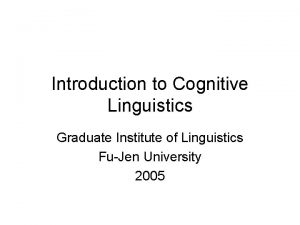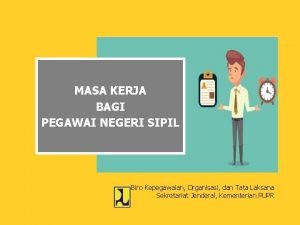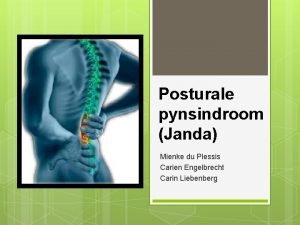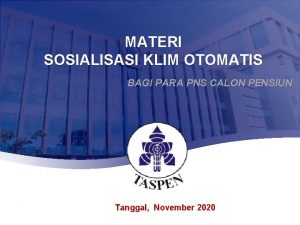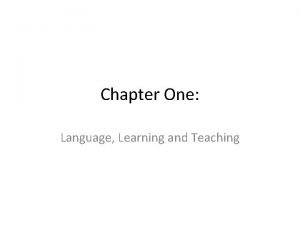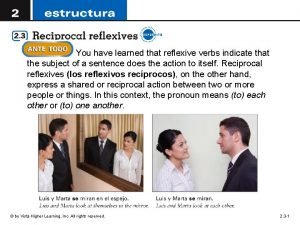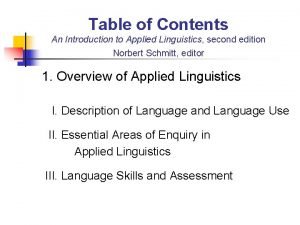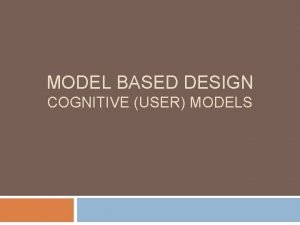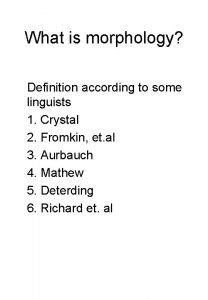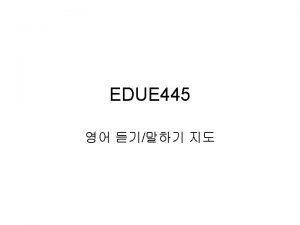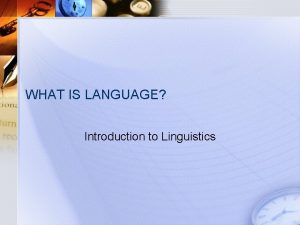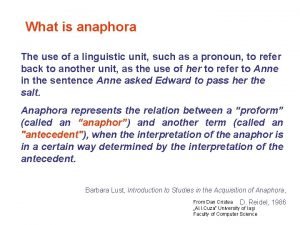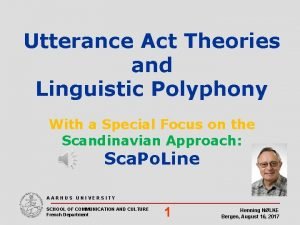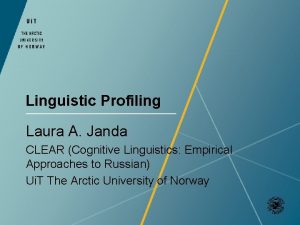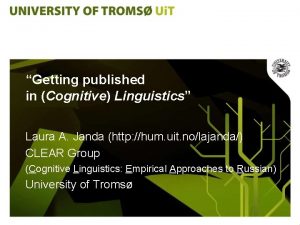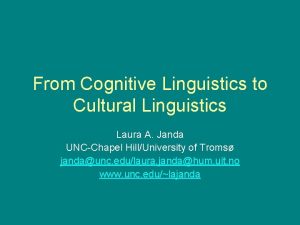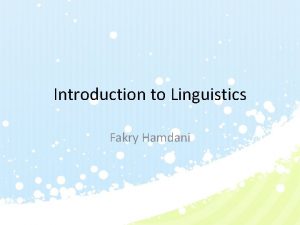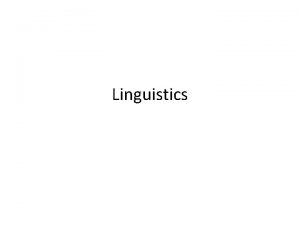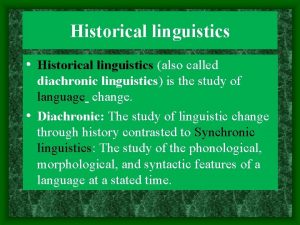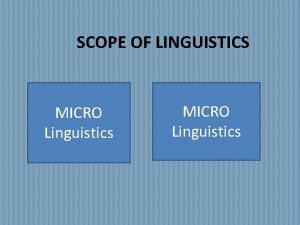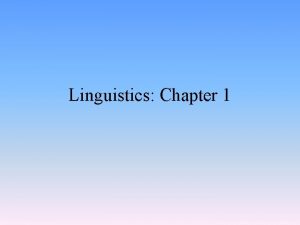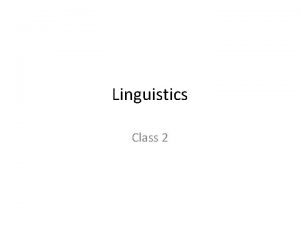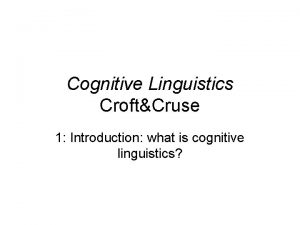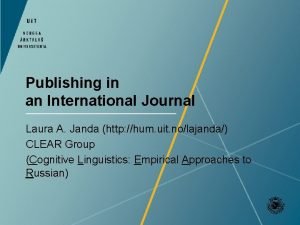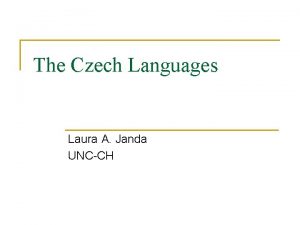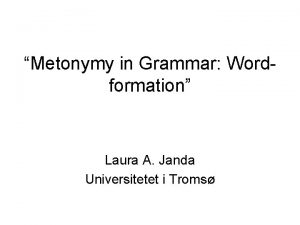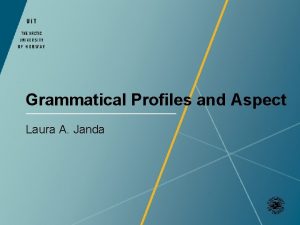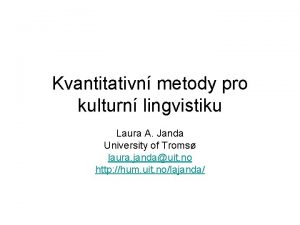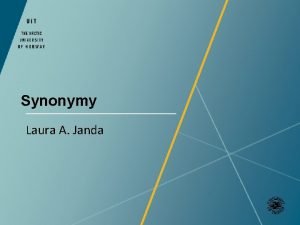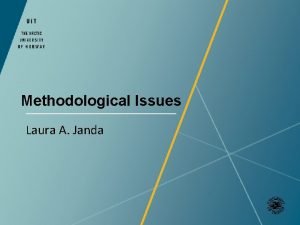An Introduction to Cognitive Linguistics Laura A Janda




















- Slides: 20

An Introduction to Cognitive Linguistics Laura A. Janda University of North Carolina at Chapel Hill

Structure of talk: n n n Introduce basic concepts of Cognitive Linguistics: category structure and metaphor Provide demonstration of role of metaphor in grammar Talk 2 on transitivity will provide demonstration of category structure

Basic concepts n n Linguistic cognition has no special status, is not autonomous in the brain The goal of linguistics is to discover structure and its motivation All linguistic phenomena are meaningful Meaning is grounded in embodied human experience

The Human Prism n n No one-to-one mapping between realworld input and linguistic output Per/conception and language conventions interact

The structure of a radial category n n Linguistic categories = cognitive categories Relationships to a prototype; no boundary Some members central, others peripheral Some members share no features genetic mother birth mother surrogate mother adoptive mother

Basic level n n Concepts are gestalts The basic level for cognitive categories is not the level of “features” – it is a middle level ¡ ¡ ¡ Superordinate level: furniture Basic level: chair Subordinate level: wheelchair

Metaphor: mapping from a source domain to a target domain n Space is source domain for in, out ¡ ¡ ¡ Target domain time: n get it done in time, running out of time Target domain emotions: n fall in love, fall out of love Target domain states: n getting in trouble, getting out of trouble

Metaphorical basis of grammar n Physical interactions in space as source domain for semantics of case and transitivity ¡ ¡ Nominative = energy source Accusative = energy sink Dative = recipient Instrumental = conduit

Matter and Russian Aspect n n n Matter provides the source domain for the metaphor that motivates aspect in Russian PERFECTIVE IS A DISCRETE SOLID OBJECT vs. IMPERFECTIVE IS A FLUID SUBSTANCE Correlation between aspectual distinctions and count/mass, number distinctions

Slavic Aspect: n n Contrasts perfective vs. imperfective (no progressive and no neutral aspect) Is independent of tense and other verbal categories Implements imperfective (as unmarked) where other languages would have perfective Has a complex and seemingly incoherent array of uses

Traditional Feature Analyses n n n Boundedness, Totality, Definiteness, Change vs. Stability, Sequencing vs. Simultaneity, Exterior vs. Interior, Figure vs. Ground, Punctuality vs. Durativity. Resultative Lack intricacy needed to account for uses Are ultimately new synonyms for perfective vs. imperfective

The ICM of Matter n n n Conflates notions of count vs. mass, solid vs. fluid, hard vs. soft, shaped vs. formless, etc. Both more narrow and more richly textured than count vs. mass (basic level) Russian has heavy morphological investment in nominal distinctions relating to this ICM (individuation)

The Two Types of Matter n Discrete Solid Object: ¡ Nut ¡ Apple ¡ Chair ¡ Pail ¡ Truck n Fluid substance: ¡ Sand ¡ Water ¡ Air ¡ Smoke

Temporal Metaphors from General to Specific: n n n TIME IS SPACE (well-documented, cf. Haspelmath 1997) A SITUATION IS A MATERIAL ENTITY (cf. comparisons of perfective vs. imperfective to count vs. mass) PERFECTIVE IS A DISCRETE SOLID OBJECT vs. IMPERFECTIVE IS A FLUID SUBSTANCE

Russian Investments in Individuation n n Number is overt, obligatory, intricate, and marked on all inflected words as sg or pl (no default general number) Russian categorizes as masses items that other languages categorize as individuals (fruits, ethnonyms) Collective and singulative suffixes Genitive/Locative singular –у for mass nouns

Russian Nominal and Verbal Morphology n n Perfective vs. Imperfective is obligatory and ubiquitous like sg vs. pl Semelfactive -ну- parallels singulative ин(к)-а Imperfectivizing suffixes parallel collective suffixes Delimitatives in по- parallel quantification of masses

The Human Observer n n n NOW is a point in the timeline, but it is occupied by a human observer The Human Observer is not a point, and interacts with situations the way that a discrete solid interacts with material entities This is important for distinguishing future time from present time, and for gnomic vs. non-gnomic

Properties of Matter and Parameters of Aspect n n n Inherent Properties -- correspond to inherent structure of situations and act as default values Interactional Properties -- correspond to discourse structure, and can override Inherent Properties Human Interactional Properties -correspond to pragmatic structure, and can override Inherent Properties

Analysis of Russian Aspect n n See the Table and the examples in your handout. The letters on the Table correspond to the lettered headings of the examples.

Beyond Slavic n n n French: more perfective than imperfective; motivated by closed vs. open or filling; attenuated number Chinese: perfective, imperfective and neutral aspect, motivated from various sources; reduced number and no formal count vs. mass distinction Navajo: Similar to Chinese, and with no number distinction
 Indexicality
Indexicality Cara menghitung masa kerja pns
Cara menghitung masa kerja pns Janda
Janda Ppt sekolah sabat
Ppt sekolah sabat Contoh pengisian formulir permintaan pembayaran taspen
Contoh pengisian formulir permintaan pembayaran taspen Language
Language Theoretical linguistics vs applied linguistics
Theoretical linguistics vs applied linguistics Structural linguistic and behavioral psychology
Structural linguistic and behavioral psychology Cognitive and non cognitive religious language
Cognitive and non cognitive religious language Laura veia a elian todos los dias
Laura veia a elian todos los dias George yule linguist
George yule linguist Introducing phonology answer key
Introducing phonology answer key Applied linguistics
Applied linguistics An introduction to model-based cognitive neuroscience
An introduction to model-based cognitive neuroscience Derivational vs inflectional morphemes
Derivational vs inflectional morphemes Linguistics as a science
Linguistics as a science Dialectology in linguistics
Dialectology in linguistics Double articulation
Double articulation Tadeusz snuk
Tadeusz snuk Cataphora
Cataphora Utterance linguistics
Utterance linguistics
